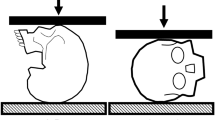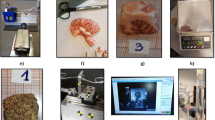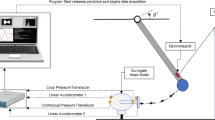Abstract
Due to the highly transient nature of head injury events that lead to traumatic brain injury (TBI) and the complexity of the human head, a structural-dynamics-informed design process is needed to augment research efforts that utilize human head surrogate models. Such models are capable of accurately mimicking the response of biological systems and allow for models that explore biological differences between individuals. This study explores the relevant mechanisms and parameters that contribute to the dynamic response of biological and additive manufactured surrogate head models and proposes an iterative design process to compare the two systems. Using experimental and finite element method (FEM) modal analysis, a balance between geometric complexity, computational resources, and manufacturability are considered when building a head model for obtaining pressures, strains, or other relevant injury indicators similar to that of a biological system. This study used a simplified ellipsoid head model to meaningfully change the response of the additive manufactured model similar to a model simulated with biological material properties. Additionally, a single layer of a digital material was used to mimic the dynamic response of the simulated head surrogate with two layers of biological materials; the scalp, and the skull. This study successfully outlined and exhibited the most basic application of a structural-dynamics-informed design process to create improved head surrogate models and to effectively compare the results from current head surrogate models to real biological systems.






Similar content being viewed by others
Data availability
The data supporting this study’s findings can be requested from the corresponding author, [Ashfaq Adnan].
References
A.B. Peterson, H. Zhou, K.E. Thomas, Disparities in traumatic brain injury-related deaths—United States, 2020. J. Safety Res. 83, 419–426 (2022). https://doi.org/10.1016/j.jsr.2022.10.001
S. Fujiwara, Y. Yanagida, Y. Mizoi, Impact-induced intracranial pressure caused by an accelerated motion of the head or by skull deformation; an experimental study using physical models of the head and neck, and ones of the skull. Forensic Sci. Int. 43(2), 159–169 (1989). https://doi.org/10.1016/0379-0738(89)90132-1
K. Laksari, L.C. Wu, M. Kurt, C. Kuo, D.C. Camarillo, Resonance of human brain under head acceleration. J. R. Soc. Interface. 12(108), 20150331 (2015). https://doi.org/10.1098/rsif.2015.0331
K. Laksari, M. Kurt, H. Babaee, S. Kleiven, D. Camarillo, Mechanistic insights into human brain impact dynamics through modal analysis. Phys. Rev. Lett. 120(13), 138101 (2018). https://doi.org/10.1103/PhysRevLett.120.138101
A. Eslaminejad, M. Hosseini-Farid, M. Ramzanpour, M. Ziejewski, G. Karami, “Determination of Mechanical Properties of Human Skull with Modal Analysis,” in Volume 3: Biomedical and Biotechnology Engineering (American Society, 2018). https://doi.org/10.1115/IMECE2018-88103
T.B. Khalil, D.C. Viano, D.L. Smith, Experimental analysis of the vibrational characteristics of the human skull. J. Sound Vib. 63(3), 351–376 (1979). https://doi.org/10.1016/0022-460X(79)90679-5
R. Willinger, L. Taleb, and P. Pradoura, Head biomechanics: from the finite element model to the physical model. Engineering, Medicine. Corpus ID: 106683365 (1995). https://www.semanticscholar.org/paper/HEAD-BIOMECHANICS%3A-FROM-THE-FINITE-ELEMENT-MODEL-TOWillinger-Taleb/5db4eb07f2b74ce512cf47b6a4e7b6d6daa64474. Accessed 14 Mar 2024
H. Lamb, On the vibrations of an elastic sphere. Proc. Lond. Math. Soc. s1–13(1), 189–212 (1881). https://doi.org/10.1112/plms/s1-13.1.189
H. Lamb, On the vibrations of a spherical shell. Proc. Lond. Math. Soc. s1–14(1), 50–56 (1882). https://doi.org/10.1112/plms/s1-14.1.50
A. W. Leissa, Vibration of shells, 1973. U.S. Government Printing Office, Washington, D.C [Online]. Available: https://ntrs.nasa.gov/api/citations/19730018197/downloads/19730018197.pdf. Accessed 8 Nov 2023
S.M. Ko, J.H. Kang, Free vibration analysis of shallow and deep ellipsoidal shells having variable thickness with and without a top opening. Acta Mech. 228(12), 4391–4409 (2017). https://doi.org/10.1007/s00707-017-1932-2
J.H. Kang, Vibrations of hemi-ellipsoidal shells of revolution with eccentricity from a three-dimensional theory. JVC/J Vib Control 21(2), 285–299 (2015). https://doi.org/10.1177/1077546313489326
Y. C. Chang and L. Demkowicz, “Vibrations of a Spherical Shell Comparison of 3-D Elasticity and Kirchhoff Shell Theory Results,” 1994.
J. Peterson, P.C. Dechow, Material properties of the human cranial vault and zygoma. Anat. Rec. A Discov. Mol. Cell. Evol. Biol.Discov Mol Cell Evol Biol 274(1), 785–797 (2003). https://doi.org/10.1002/ar.a.10096
Stratasys, Digital ABS Plus. https://www.stratasys.com/contentassets/545da59a2ed143a7b73cc0057d7e6401/mds_pj_digitalabsplus_0822a_print.pdf?v=4a5677.
A. Jackson, A. Koster, F. Hasan, A. Adnan, Impact Testing of a Surrogate Human Head Model for Correlation of Bulk Acceleration to Intracranial Pressure. Multiscale Sci. Eng. 5(1–2), 35–52 (2023). https://doi.org/10.1007/s42493-023-00090-7
S. M. Garn, S. Selby, R. Young, Scalp thickness and the fat-loss theory of balding. AMA Arch Derm Syphilol. 70(5), 601–608. https://doi.org/10.1001/archderm.1954.01540230051006
L. Falland-Cheung et al., Mechanical properties of the human scalp in tension. J. Mech. Behav. Biomed. Mater.Behav. Biomed. Mater. 84, 188–197 (2018). https://doi.org/10.1016/j.jmbbm.2018.05.024
Acknowledgements
This work has been funded by the Force Health Protection (FHP) program through Office of Naval Research (ONR) (Award # ONR:N00014-21-1-2051, ONR:N00014-20-1-2814, ONR:N00014-21-1-2043: Dr. Timothy Bentley, Program Manager).
Funding
Office of Naval Research, N00014-21-1-2051, Ashfaq Adnan, Office of Naval Research, N00014-20-1-2814, Ashfaq Adnan, Office of Naval Research, N00014-21-1-2043, Ashfaq Adnan.
Author information
Authors and Affiliations
Corresponding author
Ethics declarations
Conflict of interest
☒ The authors declare that they have no known competing financial interests or personal relationships that could have appeared to influence the work reported in this paper.
Additional information
Publisher's Note
Springer Nature remains neutral with regard to jurisdictional claims in published maps and institutional affiliations.
Rights and permissions
Springer Nature or its licensor (e.g. a society or other partner) holds exclusive rights to this article under a publishing agreement with the author(s) or other rightsholder(s); author self-archiving of the accepted manuscript version of this article is solely governed by the terms of such publishing agreement and applicable law.
About this article
Cite this article
Koster, A., Adnan, A. Dynamic Similitude of Human Head Surrogates. Multiscale Sci. Eng. (2024). https://doi.org/10.1007/s42493-024-00111-z
Received:
Revised:
Accepted:
Published:
DOI: https://doi.org/10.1007/s42493-024-00111-z




